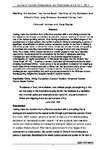Walking the Ancient Tea Horse Road: The Rise of the Outdoors and China’s First Long Distance Branded Hiking Trail
| dc.contributor.author | Jocelyn, E. | |
| dc.contributor.author | Sigley, G. | |
| dc.date.accessioned | 2018-06-22T08:59:03Z | |
| dc.date.accessioned | 2018-06-22T12:06:06Z | |
| dc.date.available | 2018-06-22T08:59:03Z | |
| dc.date.available | 2018-06-22T12:06:06Z | |
| dc.date.issued | 2014 | |
| dc.identifier.citation |
Jocelyn, E. and Sigley, G. (2014) 'Walking the ancient tea horse road: the rise of outdoors and China’s first long distance branded hiking trail', Journal of Tourism Consumption and Practice, 6(1), p.1-27 | en_US |
| dc.identifier.issn | 1757-031X | |
| dc.identifier.uri | http://hdl.handle.net/10026.1/11725 | |
| dc.description.abstract |
Having made the transition from a life-time acquired skill to something acquired by the casual tourist through a professional operator, outdoor ‘adventure’ tourism is now one of the fastest growing sectors. After having experienced the initial stages of the development of mass tourism, the tourism market in China is undergoing a period of significant diversification in which outdoor adventure tourism in the form of hiking is also a key growth area. In China the hikers, known as ‘donkey friends’, are growing in numbers and exploring new destinations to engage in short and long distance treks. As a result, whilst outdoor adventure tourism presents itself as a valuable opportunity, its development is constrained by the lack of adequate planning, management and infrastructure, and by the potential negative impacts of overcapacity on fragile ecosystems. In this paper we argue that the Ancient Tea Horse Road (ATHR) – a series of ancient trade and administrative networks criss-crossing Southwest China – could prove to be an excellent foundation for creating a world class hiking infrastructure and a hiking trail that as a brand could attract many domestic and international hikers. It is also a tool for ‘thinking out loud’ the challenges and opportunities that such a proposal presents in the Chinese context thereby giving insights into broader trends in outdoor tourism. | en_US |
| dc.language.iso | en | en_US |
| dc.publisher | University of Plymouth | |
| dc.rights | Attribution-NonCommercial-NoDerivs 3.0 United States | * |
| dc.rights.uri | http://creativecommons.org/licenses/by-nc-nd/3.0/us/ | * |
| dc.subject | China | en_US |
| dc.subject | Hiking | en_US |
| dc.subject | Ecotourism | en_US |
| dc.subject | Outdoor Tourism | en_US |
| dc.subject | Adventure Tourism | en_US |
| dc.subject | Nature-Based Tourism | en_US |
| dc.title | Walking the Ancient Tea Horse Road: The Rise of the Outdoors and China’s First Long Distance Branded Hiking Trail | en_US |
| dc.type | Article | |
| plymouth.issue | 1 | |
| plymouth.volume | 6 | |
| plymouth.journal | Journal of Tourism Consumption and Practice |



